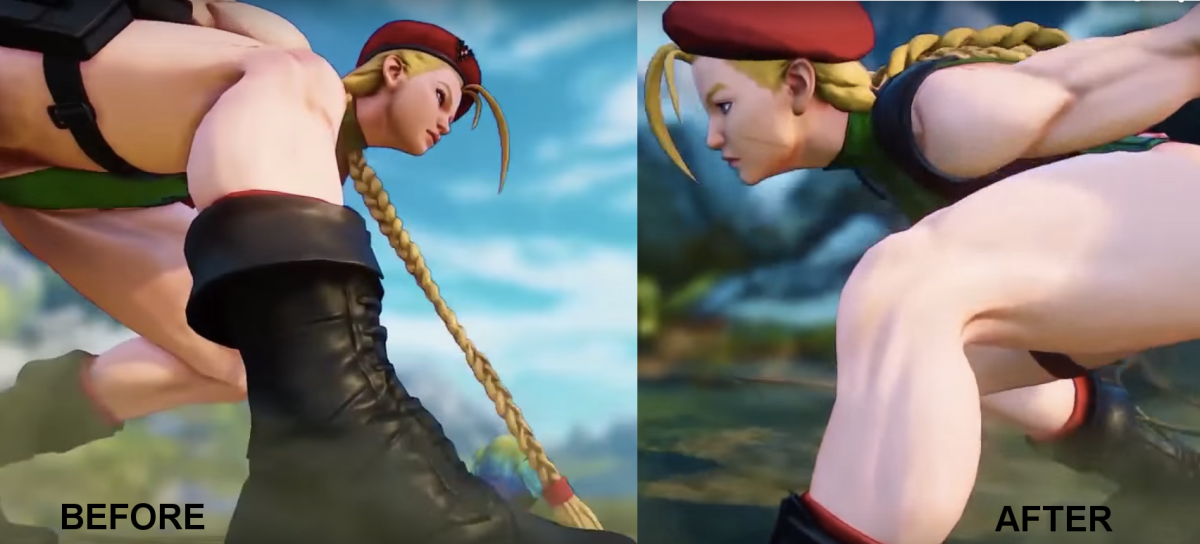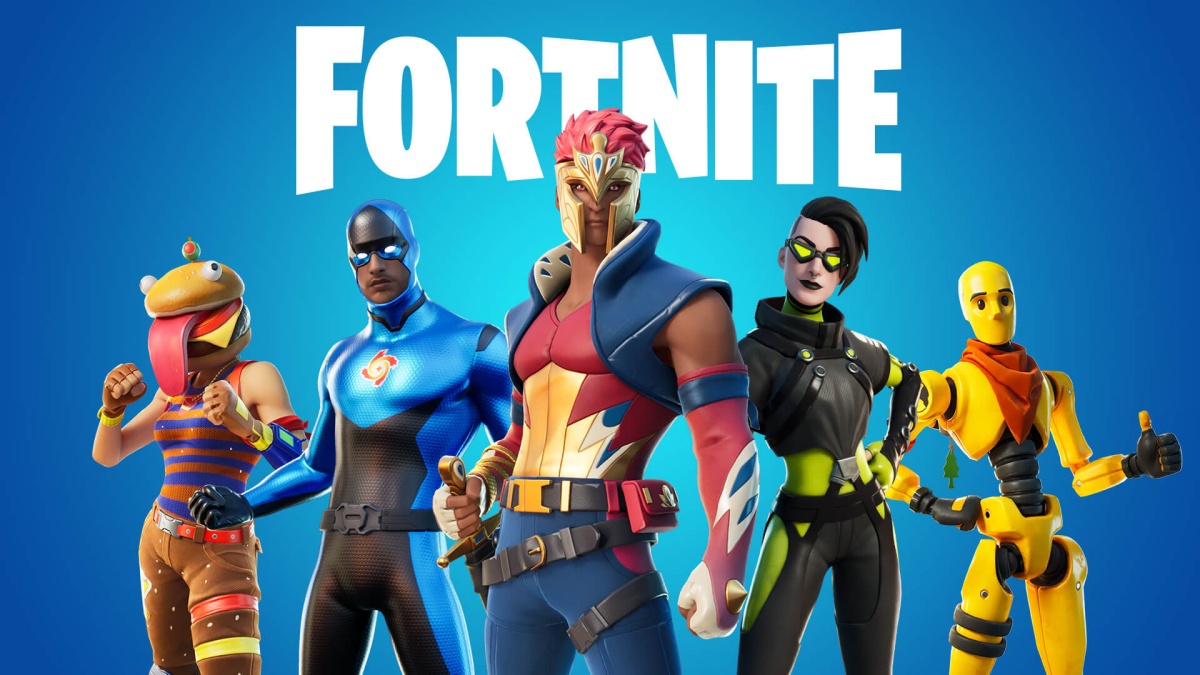Street Fighter V has undergone a lot of changes lately, given that it’s still in beta. Anyone who has pre-ordered the game — such as yours truly — has access to that beta. Each time the beta goes back online, players observe slight differences — and, in the most recent update, some people noticed a few changes in the camera angles, particularly with regard to the shots of two thong-clad female characters named Cammy and R. Mika.
A few YouTube videos have popped up decrying the changes to the camera as “censorship.” One such video, titled “Cammy Censored?!”, shows how the introductory battle animation for Cammy no longer shows the camera hovering just below her crotch. Now, the camera removes her crotch from the frame entirely, instead showing more of Cammy’s face, as well as her arm and thigh muscles. As you can see from my screenshots above, which I’ve labeled “Before” and “After,” the difference is undeniable and noticeable. Although the shot only lasts for a second at most, short opening battle animations like these are often the only forms of characterization and narrative framing offered to a fighting game character.
I’ve written several times about the camera angles in Street Fighter V; I wrote about Karin’s opening battle animation, as well as the framing of R. Mika and Cammy. In previous builds, the camera often would center Cammy’s crotch during both her opening animation and her special movies; this implies that Cammy’s crotch is what the player should want to see in center-of-frame.
The same is true for R. Mika, who is also wearing a thong in-game and whose butt is prominently featured in many of her attacks; it’s not just that she uses her butt to attack people — which she does, and her various hip-checking moves are awesome — it’s also that the camera frames her butt in the shot on the assumption that the player wants to stare at it.
The implication that these female characters choose to be sexually performative for the benefit of a presumed audience, as represented by the camera itself, is a fraught one. One can’t help but notice how coincidental it is that all of the women characters in this game just so happen to enjoy posing for the camera and/or bouncing around while not wearing a supportive bra — all while players insist that this behavior is “in character” for them. For all of them! Again, it’s quite coincidental that they’ve all “chosen” to behave according to such normative standards of attractiveness — and how coincidental, also, that they just so happen to have such similar body types, no? Anyway, can we really say that a fictional woman created by a predominantly male design team “chooses” to do anything, really? This is an argument that I tackled recently in an essay about the Halo character Cortana, who “chooses” to be naked.
Let’s leave aside the highly coincidental hotness of their outfits, attitudes, and mannerisms, however, because we’ve got bigger fish to fry. Let us now navigate the claim that Street Fighter V “censored” its own content. Some baffled folks have theorized that this has to do with ESRB ratings, but we all know that’s not what anyone’s really mad about (plus, the ESRB doesn’t care about Cammy’s thong — they never did before, so why start now?). The “censorship” anger has to do with a perceived loss of territory, I think. The new camera angles could be an acknowledgement on the part of the Street Fighter V creators that maybe, just maybe, not everyone wants Cammy’s crotch to be centered in her opening animation. Maybe, just maybe, some players would prefer to look at her muscles and her determined eyes. Could it be???
This all reminds me a little bit of that time when Hotline Miami 2 heard criticism from early previews about the inclusion of a rape scene in their game, and they decided to alter the way that scene played out — which gamers also decried as “censorship,” or “self-censorship,” at the time. The perception, both then and with this Street Fighter V situation, seems to be that the game creators are catering to perceived outsiders — not the true fan base, or the real customers. These “fake gamers” — feminists, and their ilk — are coming in to change games that they don’t even care about. This argument hinges heavily on the assumption that the folks critiquing games don’t actually play these games or care about them or have any investment in them at all.
So, speaking as a very real customer who already pre-ordered this game and therefore already gave my money to Street Fighter V, I appreciate these changes. They’re small, they’re last-minute, and they’re not perfect — but I dig what’s been changed. I have no idea what inspired the changes; it’s possible that the Street Fighter V designers just thought these angles looked better. I have to say I agree, particularly with regard to Cammy’s new shots. The game’s still in beta, so these changes might not even be final. But I hope they are, because I happen to like ’em.
Regardless of what the game creators decide, it doesn’t make sense to call their decision “censorship.” Game makers change their games based on feedback they receive from any number of sources and influences, including play-testers, staffers, friends, preview scores, etc. The only reason why this particular change is causing so much anger and betrayal is because it’s one that de-emphasizes the objectification of female characters. Other changes have happened throughout the beta, some of which have caused disappointment and frustration — but this is the first one I’ve seen that’s being called “censorship.” And that’s just not a criticism that makes any sense.
To be honest, I don’t think most players even notice the opening battle animations after a while. A lot of people skip them after seeing them once or twice; pro players tend to care more about fighters’ stats than their aesthetics. But that doesn’t mean it’s not still important to consider these narrow characterizations, because new players and newcomers to gaming do notice camera angles, costumes, and animations. By centering female characters’ boobs, butts, and crotches, and by dressing them in clothes that make it easier for those angles to zoom in on every curve, and by only showcasing certain body types, these games send a message — and it’s heard loud and clear by non-fighting game players.
Even if I don’t necessarily notice these camera angles anymore, I’ve had them pointed out to me by non-gamers enough times as reasons why they can’t get into the games, and that makes me sad. I want to be able to share these games with more of my friends, without having them feel embarrassed and put off by the way that female fighters are framed and treated by the game. I want these women characters to be treated like actual equal fighters within the game. The mechanics of the game already give them that respect — so why not the characterizations, animations, and camera angles as well?
Lastly, Eurogamer did a brief shout-out to Hot Ryu in their coverage of this issue, and I want to emphasize one more time that Street Fighter V simply does not treat its male characters in the same way. They are objectified, but not sexually objectified — I’ve written about that and the “Hot Ryu” meme at length. The camera angles used for the male characters in this game — even for an ostentatious, flirty character like Vega — do not bear any similarity to those used for female characters, at least not before the most recent updates. That said, it’s probably for the best if we don’t objectify anybody’s body parts, given that it makes people feel like crap. Instead, I prefer to see fandoms that humanize these characters — which, actually, is what I saw in many pockets of the “Hot Ryu” fandom (albeit not all of it).
I don’t mind that pro players don’t like to humanize their fighting game avatars — to them, camera angles do not matter, because they just don’t notice them anymore. But for the majority of players, these small changes do matter, because they all add up to characterize and humanize each fighter. The majority of customers don’t play professionally and do choose characters based on their own identification with that avatar — and that’s also how new people might conceivably get more into these games. Plus, it might also have the effect of emphasizing a background respect for the presence of female fighters within the games … and, therefore, more respect for the women who choose to play them. That would be a nice change of perspective.
(via Eurogamer, image via YouTube)
—Please make note of The Mary Sue’s general comment policy.—
Do you follow The Mary Sue on Twitter, Facebook, Tumblr, Pinterest, & Google +?









Published: Nov 10, 2015 04:17 pm